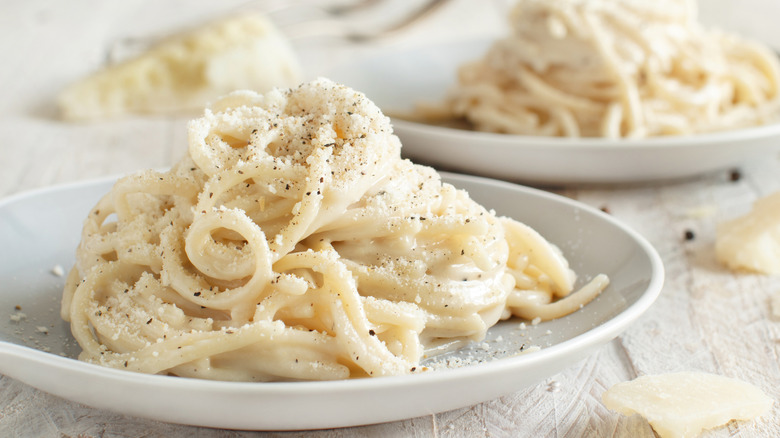Give Your Cacio E Pepe A Delicious Twist With One Simple Ingredient
There are those who believe traditional pasta dishes should not be messed with: no substitutions, no additional ingredients, and no taking anything away, lest you puncture the very soul of the dish. And then there are those who like to play with their food, so to speak. Cacio e pepe is one of those dishes that have strong support in the former group, with plenty who believe that long stranded pasta, pecorino cheese, black pepper, and pasta water are the only contenders ever allowed to be part of the Roman classic. But, we beg you to consider what a little shallot can do to this timeless favorite.
Shallots, small members of the onion family, are sweet, delicate alliums that taste like a mix between garlic and onion. When they're sautéed, caramelized, toasted, or fried, shallots are hit with a boost of major umami flavor that is irresistible. Perhaps this is why they work so well with cacio e pepe; the umami and tang of gobs of silky pecorino cheese becomes unforgettable when combined with the flavor of shallots.
By incorporating shallot, is cacio e pepe still "real?" That depends on who you ask, but the culinary realm has become what it is today by innovation and the delicate balance of ingredients enhancing one another, while maintaining respect for traditional recipes. The shallot isn't intended to disrupt the balance of this wonderful dish, rather it adds dimension to it.
How to incorporate shallots into your cacio e pepe
There are a couple of different ways you can add shallots to your cacio e pepe, the pasta dish that happens to be the one Anthony Bourdain preferred above all others. If you're making a totally authentic version with no added butter or oil, you'll want to cook your shallots separately. In a pan with oil, sauté your sliced shallots until they are caramelized. If you want them very crispy, you can deep fry them until they are lightly browned. Drain the shallots on paper towels and either stir them into your pasta dish when you're ready to serve, or use the shallots as a garnish on individual plates or bowls of pasta.
Some cacio e pepe recipes have you toast your black pepper in some olive oil or butter. Then, cooked pasta, the cheese, and pasta water are added to the same pan where everything is tossed and stirred until the pasta is coated in a silky, cheesy sauce. This is a cacio e pepe sauce that you have to work at to keep from breaking. In this case, you can simply add your sliced shallots to the pan when your pepper is toasting. The pasta will pick up the oil, which will have been flavored with shallot. If you still want some crispy shallots on top of this version, just crisp some up in a separate skillet and add them to the top right before serving.

